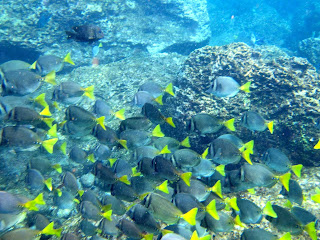After a few days in Bahia Concepcion, we started north into new territory. The first stop was just 20 miles north at Punta Chivato.
Kathryn enjoys searching for unusual shells and Punta Chivato is a great place to find them. Due to whatever combination of wind and waves, the beach is covered with shells a couple feet deep. Kathryn limited herself to just one bag full of shells.
After a couple nights at Punta Chivato, we sailed 30 miles north to Santa Rosalia, one of our favorite places to stop when we are driving back and forth to La Paz (where Agave Azul is berthed during hurricane season). The marina is small, with room for about 15 boats and it has the last gas dock as you sail north on the west coast of the Sea. There is also a dock for the ferry that sails between Santa Rosalia and Guaymas, which is on the eastern side of the Sea.
The day after we arrived, the wind picked up. The marina has a large breakwater but it was still blowing 30 knots inside the marina. We were glad to be pinned to the dock rather than on the water outside.
Some cruisers told us there was a great taco stand in town and we were glad we found it. We didn't try the tripe, but the shrimp and fish tacos were excellent. The guy who owns the stand makes it fun for all who stop to eat there.
Santa Rosalia was developed after copper was discovered and the French Compagnie du Boleo received a long term lease (1884-1954) in exchange for building the town, mine, port and establishing the Guaymas ferry. After the French left, the mine and the town went downhill until a Canadian and Korean joint venture reopened the mine in 2010.
Santa Rosalia has a church that was designed and built by Gustave Eiffel for the 1889 Paris Exposition. It was acquired a few years later by Companie du Boleo and rebuilt in Santa Rosalia in 1897.
We hoped to head a couple hundred miles further north from Santa Rosalia, but after waiting out the storm and other previous delays, it was time to head slowly south back to La Paz. The anchorage 50 miles south of Bahia Concepcion is San Juanico. We spent a few days here and enjoyed the beautiful anchorage and hikes in the hills.
A couple weeks later we met up with cruising friends at Isla San Francisco. This is one of the most picturesque anchorages in the Sea, with water so clear you can see your anchor on the bottom in 30' of water.
Yes, we did a lot of hiking this season. At Isla San Francisco, we bushwhacked over the scree one day and hiked a ridge trail the next.
Mike and Lynda provided their boat, and Bret and Marne provided hand-caught lobster for a memorable dinner before we all departed for different destinations.
After another stop at Caleta Partida, we headed back to La Paz for 2 weeks of preparing the boat for hurricane season. Here is Kathryn saying good bye to Agave Azul until next season.






































